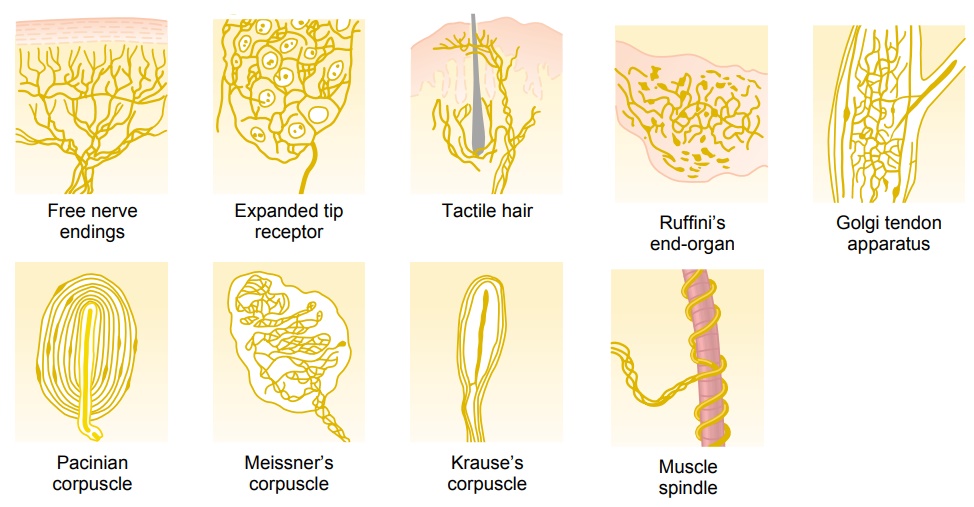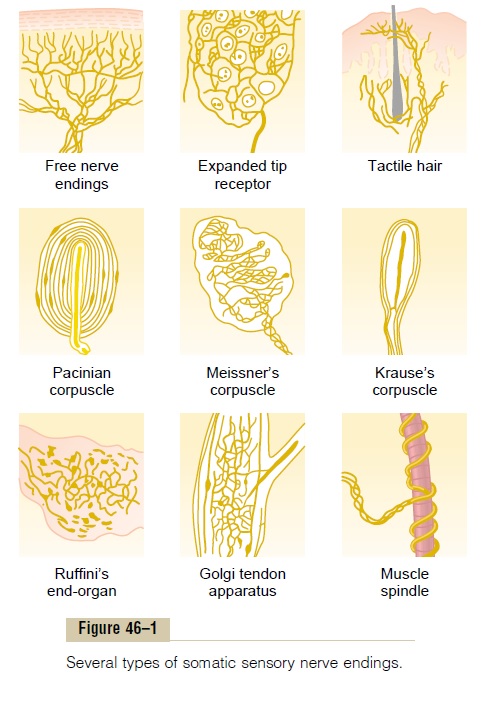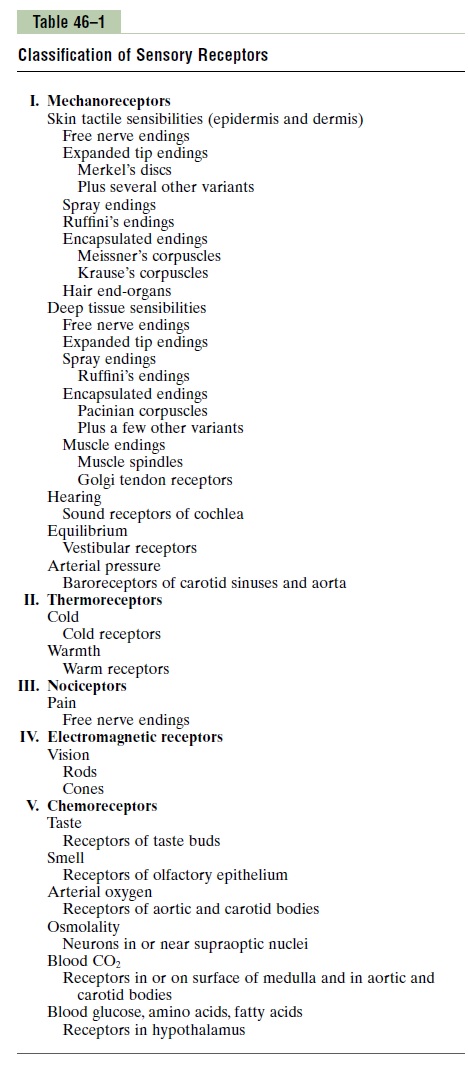Chapter: Medical Physiology: Sensory Receptors, Neuronal Circuits for Processing Information
Types of Sensory Receptors and the Sensory Stimuli They Detect

Types of Sensory Receptors and the Sensory Stimuli They Detect
Table 46–1 lists and classifies most of the body’s sensory receptors. This table shows that there are five basic types of sensory receptors: (1) mechanorecep-tors, which detect mechanical compression or stretching of the receptor or oftissues adjacent to the receptor; (2) thermoreceptors, which detect changes in temperature, some receptors detecting cold and others warmth; (3) nociceptors (pain receptors), which detect damage occurring in the tissues, whether physi-cal damage or chemical damage; (4)electromagnetic receptors, which detect light on the retina of the eye; and (5) chemoreceptors, which detect taste in the mouth, smell in the nose, oxygen level in the arterial blood, osmolality of the body fluids, carbon dioxide concentration, and perhaps other factors that make up the chemistry of the body.

We discuss the function of a few specific types of receptors, primarily peripheral mechanoreceptors, to illustrate some of the principles by which receptors operate. Figure 46–1 shows some of the types of mechanoreceptors found in the skin or in deep tissues of the body.

Differential Sensitivity of Receptors
The first question that must be answered is, how do two types of sensory recep-tors detect different types of sensory stimuli? The answer is, by “differential sen-sitivities.”That is, each type of receptor is highly sensitive to one type of stimulus for which it is designed and yet is almost nonresponsive to other types of sensory stimuli. Thus, the rods and cones of the eyes are highly responsive to light but are almost completely nonresponsive to normal ranges of heat, cold, pressure on the eyeballs, or chemical changes in the blood. The osmoreceptors of the supraoptic nuclei in the hypothalamus detect minute changes in the osmolality of the body fluids but have never been known to respond to sound. Finally, pain receptors in the skin are almost never stimulated by usual touch or pressure stimuli but do become highly active the moment tactile stimuli become severe enough to damage the tissues.
Modality of Sensation—The “Labeled Line” Principle
Each of the principal types of sensation that we can experience—pain, touch, sight, sound, and so forth—is called a modality of sensation. Yet despite the fact that we experience these different modalities of sensation, nerve fibers transmit only impulses. Therefore, how is it that different nerve fibers transmit different modalities of sensation?
The answer is that each nerve tract terminates at a specific point in the central nervous system, and the type of sensation felt when a nerve fiber is stimu-lated is determined by the point in the nervous system to which the fiber leads. For instance, if a pain fiber is stimulated, the person perceives pain regardless of what type of stimulus excites the fiber. The stimulus can be electricity, overheating of the fiber, crushing of the fiber, or stimulation of the pain nerve ending by damage to the tissue cells. In all these instances, the person perceives pain. Likewise, if a touch fiber is stimulated by electrical excitation of a touch receptor or in any other way, the person perceives touch because touch fibers lead to specific touch areas in the brain. Similarly, fibers from the retina of the eye terminate in the vision areas of the brain, fibers from the ear terminate in the auditory areas of the brain, and temperature fibers terminate in the temperature areas.
This specificity of nerve fibers for transmitting only one modality of sensation is called the labeled line principle.
Related Topics